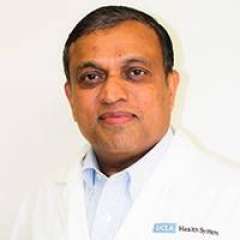A multidisciplinary team of neonatal and perinatal experts at UCLA Mattel Children’s Hospital is serving as an increasingly vital referral resource for addressing a broad range of congenital conditions during pregnancy and immediately after delivery.
“We are seeing a major shift in which many significant congenital abnormalities and malformations are diagnosed in utero,” says Suhas G. Kallapur, MD, director of the neonatal intensive care units at Ronald Reagan UCLA Medical Center and UCLA Santa Monica Medical Center. “These conditions are being detected with greater frequency in the community because of the widespread use of ultrasound and other diagnostic and genetic tests.”
Beyond the increase in prenatal diagnosis, Dr. Kallapur notes, more interventions are now offered at UCLA and other major centers once the diagnosis has been made. In response to these developments, UCLA Health’s multidisciplinary perinatal newborn group has grown in depth, sophistication and level of participation, says Dr. Kallapur, one of the group’s key members. “
When a pregnancy is flagged for potential concern related to congenital malformations — whether it’s known to be a high-risk pregnancy or something abnormal is found on the ultrasound at the midpoint in pregnancy — the mother can be referred here for a higher level of consultation,” he explains.
In addition to neonatologists and maternal and fetal medicine experts, the group includes subspecialists in cardiology, pediatric surgery, radiology, genetics and other subspecialties. These experts meet on a regular basis to discuss cases brought to them before providing consultation and counseling for the family. Specialists outside the group are called in to assist as warranted.
The perinatal-newborn group serves several important purposes. One is to draw on the expert specialists to confirm the diagnosis. The group then develops a methodical treatment plan — be it for prenatal interventions or for timely treatment immediately after the birth.
As part of the process, the group does a risk stratification to assist in planning the treatment and maximizing the likelihood of the best possible outcome. For example, Dr. Kallapur notes, when the fetus is found to have a congenital diaphragmatic hernia, a potentially fatal condition in which the lungs are not properly formed, an MRI of the pregnant mother can help to predict lung function and guide the treatment plan. In cases where there are airway abnormalities, an ear, nose and throat specialist can be on hand at the time of delivery to secure the airway in the newborn.

For families, gaining clarity on the diagnosis and treatment course helps to reduce the level of uncertainty. “We counsel families about their infant’s condition and what to expect, and we give them information that can help them plan their lives,” Dr. Kallapur says. “Some of them may need to spend an extended period in the NICU, for example, and that typically requires making provisions in advance.”
In the U.S., approximately 3% of babies are born with some type of birth defect or congenital abnormality. These cover heart, kidneys, brain and spinal cord. The most common are congenital heart conditions, which affect about one in 100 pregnancies. The majority of these are considered low risk and don’t require immediate interventions, Dr. Kallapur says. But certain heart defects can be life-threatening; in such cases, time is of the essence in getting the newborn to surgery, and an advanced-level NICU provides urgent medical treatment before the operation.
Genetic conditions are found more often than in the past, both because of advances in diagnostic testing and because more women are postponing childbirth, with the risk of some genetic conditions higher among older mothers.
With so many more interventions available now than in the past to address congenital conditions, referring to a group such as UCLA’s has taken on added significance. “For these types of cases,” Dr. Kallapur says, “you need a high level of expertise and sophistication across disciplines to ensure appropriate and timely care.”
Learn more about neonatal care at UCLA Health.
Dan Gordon is the author of this article.




